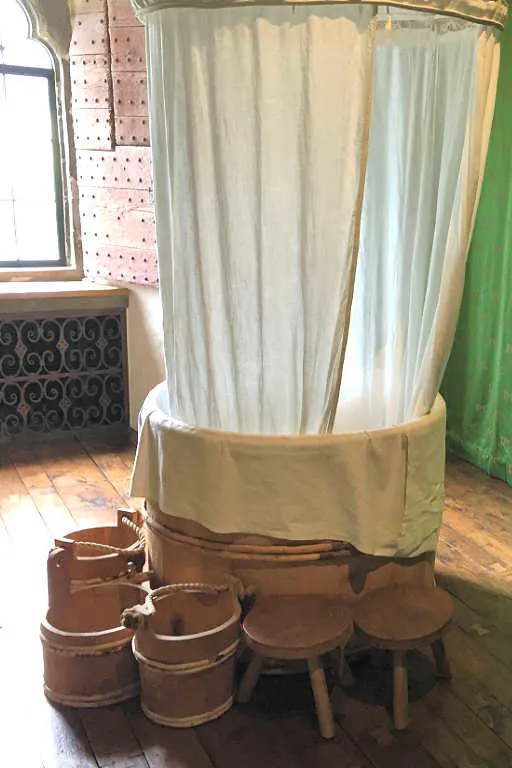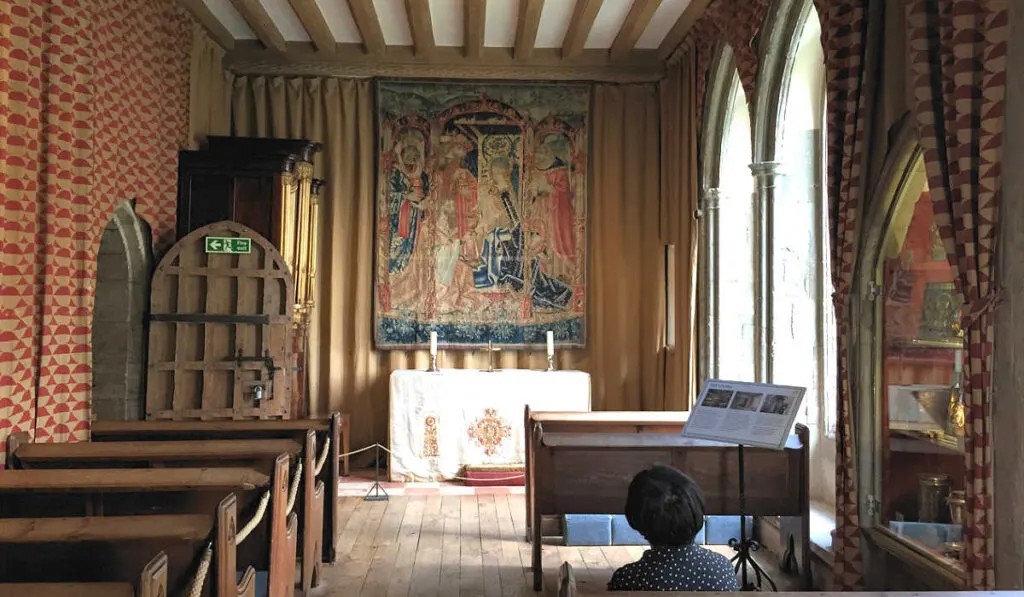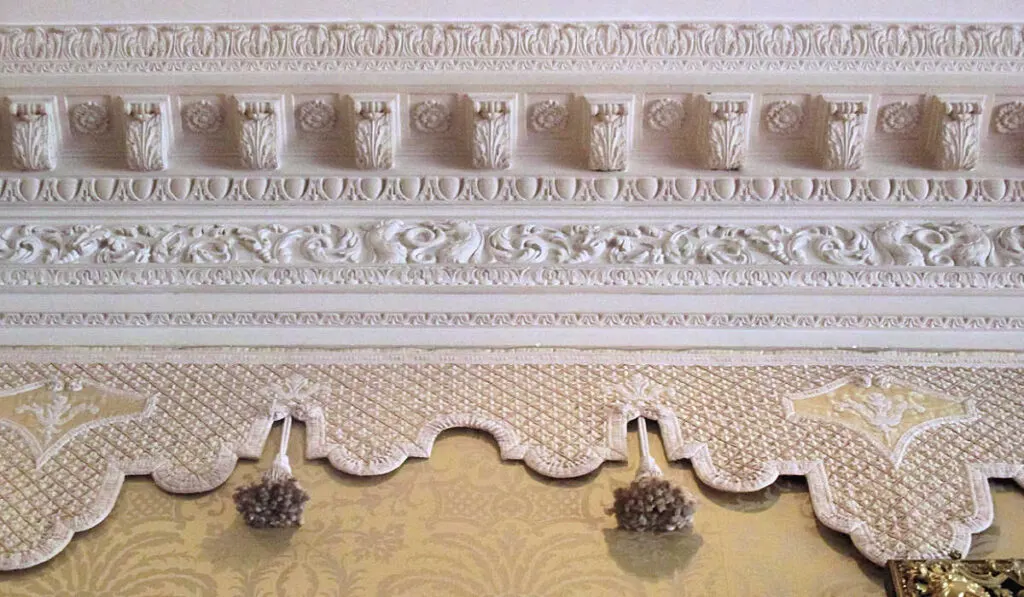
Steeped in history, picturesque Leeds Castle is the quintessential fairy-tale castle. It was named “The loveliest castle in the world,” and after one visit, it’s hard not to agree.
The castle sits on 500 acres of pristine gardens and parklands in southeast England. Built on a small island and surrounded by a moat, essentially, it’s the perfect setting for what most imagine as a real fairy tale castle.
As one of the most beautiful castles in England, other castles like Hever Castle or Arundel Castle also stand alone as impressive structures worth visiting.
Quick tips for visiting Leeds Castle
Skip the line and get your tickets here. This ultimate explorer ticket includes the maze, train, ferry and adventure golf.
Looking to stay at Leeds Castle?
Leeds Castle Bed and Breakfast – Stay in the Stable Courtyard, which includes free entry to the castle.
Leeds Castle Glamping – Enjoy a Medieval stay with a four post bed.
Leeds Castle Location
While most might assume it’s located in Leeds, it’s located in Maidstone, Kent. An outing to the castle is easily accessible by motorcoach, private vehicle, or train from London. Parking is free should you choose to drive as I did.
The exact address is Broomfield, Maidstone, Kent, ME17 1PL. If driving from London, take the junction 8 exit off the M20 motorway, then follow the brown and white signs to the castle.
Getting to and visiting Kent Castle is easy since the directions are well marked.
When visiting Leeds Castle, consider combining your day with a trip to Canterbury Cathedral, just thirty minutes east. Known as the “Garden of England,” it’s one of England’s oldest and best cathedrals.
Castle Pricing
For 2023, an adult ticket costs GBP 35 with discounted rates for children, seniors, and visitors with a disability. While some consider the ticket price rather expensive, it’s good to note the pricing includes yearly entry. Expect to pay an additional free for boat rides, train rides and golfing.

Inside the gate, the walk to the castle is rather long, but the pathway is flat. If you have mobility issues, the castle provides a train. Exciting the wooded area, the sight of this fairy tale castle takes your breath away.
Its stone building towers over a beautiful English garden of wildflowers and lush green lawns.
Leeds Castle History
The Gatehouse Exhibition brings Leeds Castle’s history to life, and I was amazed by how much the main building had changed over the centuries. Once the structure became an abandoned castle when destroyed by an enormous fire.
But having been rebuilt several times, the structure has grown into a magnificent estate treasured by Britain.
It has been home to six medieval queens and served as a military hospital during World War II. It became a royal castle in 1278 when Queen Eleanor, wife of King Edward I, purchased the castle.

Learning its history, it’s astonishing the castle has survived through perils and conflicts. But one thing that still stands true is the building hasn’t lost any of its opulence.
Outside, a small building houses the Dog Collar Museum, a unique collection of over 130 valuable and rare dog collars. While dog collars seem like strange items to collect, some objects are distinctive and interesting to see.
Among the collection are some incredibly barbaric samples with fearsome spikes. In contrast, other overly embellished collars served as more decorative canine accessories rather than functional items.
Once inside the castle, I was free to roam the staterooms. The floor plan is simple to navigate, with rooms easily flowing into other spaces. The Castle View Restaurants provides a great place to have lunch and their shop offers seasonal changing gifts and UK-inspired souvenirs.
During my visit, I enjoyed the following rooms.
The Heraldry Room
In 1822, the Heraldry Room was part of the Great Hall. The last owner, Lady Baillie altered the space to make a library, and it later became a servant’s room. At the time of alteration in 1927, a beautiful plaster ceiling was added, which you can see today.

The Heraldry Room derives its name from the display of coats of arms from previous Leeds Castle owners. On the walls are portraits of the Fairfax family or persons related to them by marriage, who owned the castle for the better part of the 18th century.
Also, plenty of information sheets for the self-guided tours were available in many languages. There are also interactive pages for children of all ages, and during my last visit, several groups of school children were touring the castle.
The Queen’s Room
Today, the Queen’s Room looks as it did in the 1420s due to the restoration work. Henry V’s widow, Catherine de Valois, owned the castle during that time.
Over the chimneypiece is Queen Catherine’s coat of arms in the shape of a lozenge which shows that she is a widow. The oversized bed was rarely used but was decorated in fine silks to impress visitors who came into this room.
The bed was beautifully draped and fit for royalty. H and C mark the wall covering and linens representing Henry and Catherine.
The Queen’s Bathroom
A simple wooden tub encircled by an elegant white curtain adorned the large bathroom. Such an opulent bath denotes the high status of the person that lives there.

Although palatial for its time, this simple bathroom gave me a great appreciation for modern-day plumbing. I couldn’t imagine how many trips it would take to fill that deep tub with those wooden buckets.
The Queen’s Gallery
In 1927, Lady Baillie hired French architect Armand Rateau to refurbish this part of Leeds Castle. The rich wood floors feature double dovetail joints, complemented by the addition of beautifully carved oak beams on the ceiling.
This room also features marble busts of Henry VIII and his three children and an emblem of Henry and Catherine over the fireplace.
Henry VIII Banqueting Hall

The Henry VIII Banqueting Hall is a lavish room on a grand scale. Due to the lack of natural light, I found this space unwelcoming.
Long, narrow, and dimly lit, I couldn’t imagine how difficult it was to heat a room of this magnitude during its prime.
Armand Rateau refurbished this room with the addition of carved beams and the impressive ebony door. He also added 16th-century items brought over from France and Belgium. Even though Mr. Rateau renovated this room, it still retains its old-world charm.
The room got its name from its famous king, who installed the magnificent bay window.
The Chapel

The chapel is a small space and has been a place of worship in the castle since 1293. It ceased to exist between 1544 and 1978 because King Henry VIII closed it down.
Although small compared to the other spaces in the castle, delicate tapestries and fabric panels delightfully decorated the chapel.
The Seminar Room

Decorated in calming colors, the Seminar Room was formerly Lady Baillie’s boudoir (sitting room) until the 1960s. It later became her son’s bedroom. It was only after her death in 1974, that it became a seminar room.
In 1978, the chamber hosted meetings between the USA, Egypt, and Israel, leading to the Camp David Agreement.
The Yellow Bedroom
Catherine of Aragon, King Henry VIII’s first wife, initially used this room as part of her private quarters. Later, Lady Baillie had the room refurbished into a bedroom with an adjoining marble bathroom.
Throughout the years, the lavish castle entertained many high society guests, from Charlie Chaplin to David Niven. Those guests stayed in the yellow bedroom along with 23 other bedrooms.
Today, these 24 castle bedrooms remain used by guests at weddings, meetings, and other special functions. If your dream is to stay in a castle, Leeds castle can accommodate you if your budget allows.
Lady Baillie’s Bedroom

Designed in 1936 by renowned French interior decorator Stephane Boudin, this bedroom has French Regency flair. Stephane Boudin was considered the “greatest designer in the world.”
Boudin designed interiors in the White House and the Duke and Duchess of Windsor’s Paris apartments. However, Lady Baillie’s bedroom is the rarest surviving example of Boudin’s work.
Recently, the “blue bedroom” underwent an extensive restoration, and it’s the only bedroom in the castle not in use today.
After Lady Baillie died in 1974, her trust, the Leeds Castle Foundation, maintained the estate.
The Yellow Drawing Room

The Yellow Drawing Room is a guest’s favorite room with its Palladian chimneypiece. Once an oak-paneled library, the room was redecorated in 1938 when the chimneypiece was added and the wood panels replaced with silk.
This room’s Opulent gold silk walls make a striking statement and bring a sense of calmness to the room. Stephane Boudin designed the tasseled hangings called a lambrequin that circle the place below the cornice.
Being a quilter, I thought these quilted wall hangings were stunning. This room was extensively refurbished in 2017 when the lambrequin was removed and sent to a conservation studio to be repaired and cleaned.
When visiting this room, remember to look up because the cornices and lambrequin are a work of art.
The Thorpe Drawing Room

Since 1822, this room has served as the principal drawing room within the castle. The pine paneling and marble chimneypiece came from Thorpe Hall, Peterborough, where the place derives its name.
The porcelain birds and lacquered wood screens are Chinese, dating from the 17th century.
The Library
Boudin designed this room in 1938 after a library at Boughton House, Northamptonshire. This library contains approximately 3000 books.
A large portrait of Lady Baillie and her two daughters dominates the room and is a copy of a smaller one from the Seminar room.
The Dining Room
The dining room has served many purposes over the years. Originally a dining room, it was once divided into the servants’ hall and steward’s room.

However, in 1938, Lady Baillie commissioned Stephane Boudin to restore the space to a dining room. During the restoration, the room revealed many layers of paint colors, from ivory to water-green.
Today, the beautiful shade of muted green resembles that of its original color. The color change completes Boudin’s vision of harmonizing the color of walls, carpets, French tapestries, and accessories Chinese porcelain.
During my last visit, the castle had arranged the dining room for a private wedding that afternoon. Imagine having your fairy-tale wedding in a magnificent castle. It sounds like the perfect fairy-tale story to me!
Leeds Castle Gardens and Grounds
Outside the magnificent castle, there are extensive parklands with over 500 acres of property. One of the extensive gardens’ treasures is the castle’s maze, one of the better hedge mazes I have experienced.
Exploring the maze is a must for kids and adults alike (yes, I’m still a big kid at heart!). I remember wandering through the maze back in the 1990s when the yew trees were pretty new.
Wooden trellises support the trees enabling the hedge to grow dense and straight. Today, the lattices are gone, and the hedge is thick, preventing visitors from seeing through other pathways or taking shortcuts.

The yew tree maze is a circle within a square, making it more challenging than the average maze.
Once you reach the labyrinth center, you exit through an underground cavern with mystical creatures made of shells and wood. The castle Grotto is the “prize” for completing the maze, and what a treat it is.
The bird of prey center is very close to the hedge maze. It houses a variety of birds, from kestrels to eagles and lots of owls.
A falconry show runs at 2 pm each day during the summer months and only on weekends in the winter.
When I visited, they had the most adorable (and large) baby owl with beady red eyes and fluffy baby feathers. It’s the sort of creature that melts your heart and makes you ask, “can I take him home?”

For the kids, there are two playground areas. Firstly, the very appropriately named Knights of the Realm Playground for older children. Secondly, the Squire’s Playground for the smaller ones.
If you are a little adventurous, why not take a Segway tour? They are easy to ride and add a bit of fun to your day. You don’t need a castle tour ticket to ride.
Castle Accommodation and Events
If you want to explore the castle longer, consider staying overnight. The English castle provides lovely hotel rooms, fit for a king or queen.
The estate has traditional cottages and bed and breakfast in the Stable Courtyard Bedrooms and Maidens Tower. Both include breakfast and access to the castle.
Are you looking for a less expensive option to escape to the countryside for a glamorous camping experience? Try Glamping!
Knights Glamping allows you to enjoy one of eight beautiful pavilion tents with four-poster beds, crisp cotton bedding, and a wood stove.
While I’m not big on camping, I could consider Glamping (I think I was sold on the four-poster bed, haha).
The estate holds summer concerts, Festival of Flowers, Christmas Market, and murder mysteries throughout the year. The Castle’s Festival of Flowers event attracts over 16,000 people each September and is an absolute show-stopper.
If you’re planning a wedding, this Kent Castle is the most romantic place to hold your wedding ceremony and can accommodate your overnight guests.
On my last visit, they were preparing for a wedding. I couldn’t help but think this was the perfect place to tie the knot.

Final Thoughts
While I have visited Leeds Castle several times, it’s still one of my favorite castles in England. Each time, the castle has been meticulously maintained both inside and out.
Although Leeds Castle pictures look lovely, seeing the castle far exceeds every photo I have viewed.
While most guests visit in the summer months, consider visiting Leeds Castle in the off-season. Its Christmas displays are incredible and give a different castle perspective.
There are many reasons to be in love with this place, from its fairy-tale setting to its magnificent grounds. While some might find the entrance fee a wee bit pricey, your ticket is good for a whole year.
There is no need to hang on to the ticket stub. On future visits, the castle staff finds your photograph on their database.
If you had to choose a castle to visit, this is the place to go. It’s romantic, magical, and “the loveliest castle in the world.”
